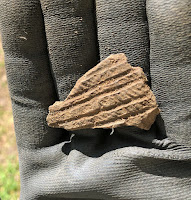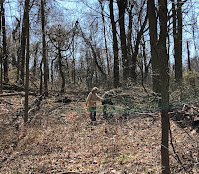The Archaeological Society of Maryland, Inc (ASM) in cooperation with the Maryland
Historical Trust (MHT) held their 52th Field Session May 19 - May 29, 2023, at the Chapel Branch West Site in Denton, Caroline County, Maryland. Once again Dr. Julie
Markin, Associate
Professor of Anthropology at Washington College, was the principal investigator. Julie was assisted by MHT archaeologists Matt McKnight, Zac Singer, and Stephanie Soder.
 |
| Julie Markin with Zac Singer |
The Chapel Branch West Site near the Choptank River is a
pre-Colonial site that is right next to the colonial
Barwick’s Ordinary site we investigated last year. The site that is shaded by trees, and the moderate weather made this a really enjoyable field session. Of course, a Field Session is to gain information about the site.
During the 2022 Field Session, a shovel test pit survey documented a
buried living surface below the plow zone. This Field Session was to
investigate that buried layer.
 |
| Chapel Branch West Site |
We tended to work in only a small area and
will have to wait for the report when all the data is pulled together to see
the bigger picture. There was plenty of opportunities to dig, trowel, map, document, work in
the lab, and screen whether it was your first time or hundredth time. There were lots of opportunities to screen. But the Field Session also gave us a chance to reconnect with old friends, and to meet
new people.
Since this site is on the Eastern Shore, we encountered pottery not found in Charles County -- grog-tempered Coulbourne, various tempered Minguannan, at least one piece of rock tempered Vinette, and other unidentified sherds -- as well as some shell tempered Townsend which is found in Charles County. The points encountered were triangular. And the predominate lithic material was chert - a number of different types.
 |
| Troweling (Carol and Evelyn) |
 |
| Unidentified Sherd (recovered by Carol) |
 |
| Point (recovered by Pat) |
It's always good to learn something new whether in the field leaning how to trowel or by attending talks and workshops at the Field Session. There were two CAT Workshops
-- (1)Legal & Ethics and (2)Mapping. There were also two hands-on lunchtime talks. Lynn Bulhack talked about interpreting ceramics. (You could also visit with Lynn at the lab tent where she used Sculpey to make impression of the surface of sherds.) Zac Singer gave an overview of Maryland
projectile points and passed around examples for us to view.
The annual Spencer O Geasey Memorial
Lecture was given by Dr. Zac Singer, State Terrestrial Archaeologist, who provided example of ceramics that
would be found on the Eastern Shore. That was followed by Dr. Julie Markin
giving an an update on what was found last year's field session at Barwick's Ordinary.
 |
| Children on site |
This year there was a special session for children (limited to ten children) on Saturday morning that was organized by the Eastern Shore Chapter. This photo is not from the special session, but shows some of the children that stayed for the afternoon.
And a Field Session wouldn't be complete without the annual Saturday night "feast". The property owners provided all the food and drinks in their backyard overlooking the river. A special thanks to the property owner, not only for the feast, but for all they did to accommodate those at the field session and those camping as well as for their on-going support.
While thanking people, another special thanks to the ASM members that helped make this Field Session happen - from planning to registration to getting t-shirts to taking care of the lab to .... all the behind-the-scene things that need to happen. You do so much. Thanks.
Three CCASM members (Pat, Evelyn, and Carol) attended the field session for multiple days, but not necessarily the same days.







































